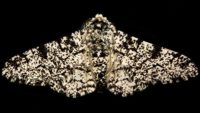By Dr. Jason Lisle Physics dealing with how the universe operates at very small scales—interactions involving particles smaller than atoms—is called quantum mechanics. …read more Source: AIG Daily
For more than a century, biologists have appealed to Darwinian natural selection to explain how living organisms adapt to different environments. But research over the last several decades has consistently dethroned Darwin’s view of natural selection. Rather than corroborating the concept that environments mold creatures through “survival of the fittest,” the research supports the astonishing idea that to a great extent creature… More… …read more Source: icr.org
By Dr. Danny R. Faulkner Dr. Danny Faulkner evaluates 23 arguments for recent origin for the sun, stars, and galaxies. …read more Source: AIG Daily
By Ken Ham If you’ve ever smelled a meteorite, it probably didn’t have much of an aroma. But that’s not the case with the newest addition to the Field Museum of Natural History in Chicago. This four-pound visitor from outer space (a rare stony meteorite that is called a carbonaceous chondrite) crashed down in Costa Rica’s Alajuela province back in April. And when scientists received the sample, it smelled distinctly like Brussels sprouts! Why—and what does that have to do with creation and evolution? Well, to answer that question, I’ll share some of the text from the article, answering the [More]
By Dr. Danny R. Faulkner Two recent studies of astronomical interest have been in the news. Both are about planets: one near (Saturn) and one far (K2-18b). …read more Source: AIG Daily
A team has come up with an interesting universal addressing system. But did you know living things have a solution to their own ‘address problem’? …read more Source: creation.com
The ability to distinguish the style of a Picasso from a Monet puts a whole new perspective on ‘bird-brainy’ …read more Source: creation.com
New research goes a long way in explaining how creatures actively sense their environment and adapt to it. One mechanism enables some organisms to track the changing levels of nutrients, hormones, or stress they are exposed to, and then make appropriate responses if and when needed. Andrew Capaldi’s lab at the University of Arizona is responsible for these remarkable findings published in Nature Communications.1 Hi… More… …read more Source: icr.org
Is the physical data enough to justify any cosmological theory? …read more Source: creation.com
By Dr. John H. Whitmore The cross-bedded Coconino Sandstone (lower Permian, Arizona) is often used as a “type” ancient eolian sandstone. …read more Source: AIG Daily
By Dr. Tommy Mitchell The story of the peppered moth has been set forth for decades as the prime example of evolution in action. But, are they really evidence of evolution? …read more Source: AIG Daily
Many people of European descent have less melanin in their eyes, and it’s got nothing to do with evolution …read more Source: creation.com
Evolutionary scientists are continually searching for evidence of the “first life” on Earth. Their most recent claim involves well-preserved stromatolite fossils from Australia. Stromatolites are finely laminated biomats formed by colonial cyanobacteria—a complex type of photosynthetic bacteria. Fossil stromatolites are found in mounded structures similar to modern stromatolites. The fossils aren’t composed of the ba… More… …read more Source: icr.org
By Harry F. Sanders, III Because of their isolated natural habitats, guppy populations have been used to study the processes of “evolution” in the wild. …read more Source: AIG Daily
New findings continue to support ICR’s theoretical assumption that biological functions are best explained by engineering principles.1 These findings challenge long-held Darwinian assumptions that the environment is responsible for “selecting” creatures, causing them to adapt. Rather, creatures appear designed from the start to sense their environment and adapt accordingly. The latest research comes from the lab… More… …read more Source: icr.org
A recent study making the news involves the reconstruction of the facial features and anatomy of the enigmatic humans known as the Denisovan from genetic data.1 In the evolutionist’s own words who did the study, “Denisovans are an extinct group of humans.” And the scientists’ research shows exactly that. Denisovan fossils are represented by only a few teeth, a finger bone, a bit of a mandi… More… …read more Source: icr.org
An insurmountable impediment to evolution. …read more Source: creation.com
By Ken Ham You may have seen headlines recently with phrases like “lizard-men evolution,” “leftovers from our lizard evolution,” or even “human embryos go through lizard stage.” These headlines were reporting on a study that claims that human embryos (babies in the early stages of development) supposedly have muscles not found in adult humans, but are found in lizards. Therefore, these evolutionists believe this is a throwback to 250 million years ago when we shared a common ancestor with lizards. But what does a world-class anatomist who specialized in embryology have to say about this research? Well, he summed …read [More]
By Prof. Stuart Burgess Don’t look now, but you’re being watched by an amazing variety of magnificent eyes. …read more Source: AIG Daily
Big Bang scientists recently used a new method to estimate the universe’s age. This method yields an age estimate that could be over two billion years younger than their current age estimate of 13.8 billion years.1,2 However, this new method has large uncertainties, so not too much can be made of this result. It’s mainly of interest because it reminds us how Big Bang age estimates often contradict one another. … More… …read more Source: icr.org
By Harry F. Sanders, III Since plants are unable to simply get up and walk, or even shout when in danger, we often think of plants as passive. …read more Source: AIG Daily
Their survival is hard to explain, but after a little digging, answers start to emerge. …read more Source: creation.com
By Ken Ham In today’s world we often hear statements like “science disproves creation” or “science proves evolution.” …read more Source: AIG Daily
Do evolutionists really say that the bones, joints, muscles, nerves and eardrum really turn into the middle ear of mammals? Unheard of! …read more Source: creation.com
When and how did dogs diversify after Noah’s Flood? …read more Source: creation.com
By Troy Lacey Human vision is incredible. The human eye and brain are adept at recognizing objects, even when they are not fully visible or oriented at different angles. …read more Source: AIG Daily
By Ken Ham Naturalistic scientists disagree on the age of Saturn’s rings. NASA’s Cassini spacecraft had a planned crash into the planet in 2017. The data that it gave was interpreted as evidence that Saturn’s pristine rings formed just 200 million years ago in the evolutionary timescale of our solar system. But a new study disagrees. It states that “processes that preferentially eject dusty and organic material out of Saturn’s rings could make the rings look much younger than they actually are.” This study says the rings are 4.5 billion years old. So exactly how old are Saturn’s rings? …read [More]













































